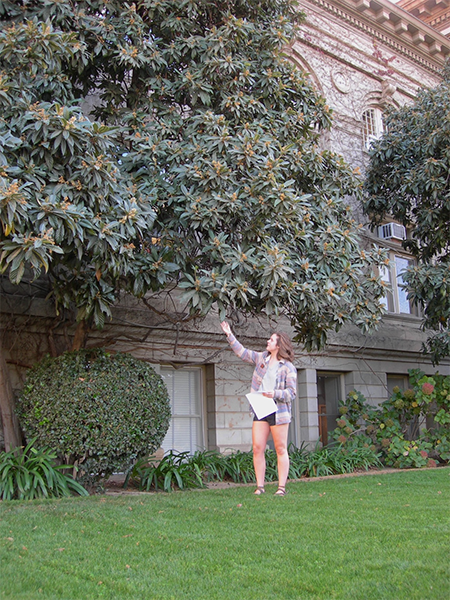Common Name: Loquat Tree; Japanese Medlar
Scientific Name: Eriobotrya japonica
Family: Rosaceae
Identification
Habit: Dense evergreen bush or short tree. Can grow to be 20-30 ft (6-9 m) tall, but is more often about 10 ft (3 m). Overall rounded crown shape.
 selectree.calpoly.edu/tree-detail/eriobotrya-japonica
selectree.calpoly.edu/tree-detail/eriobotrya-japonica
Leaves: Leaves are about 5-12 in (12.5-30 cm) long and 3-4 in (7.5-10 cm) wide. Dark green and glossy on the top side, whitish and a bit hairy on the bottom. Thick and stiff with obvious parallel lines (veins).
 https://commons.wikimedia.org/wiki/Eriobotrya_japonica
https://commons.wikimedia.org/wiki/Eriobotrya_japonica
Twigs & Bark: Twigs are thick and slightly fuzzy. Bark is dark grey-brown and usually smooth.
 selectree.calpoly.edu/tree-detail/eriobotrya-japonica
selectree.calpoly.edu/tree-detail/eriobotrya-japonica
Flowers & Fruits: Flowers are small and white and bloom in fall or early winter. Fruits, grown in clusters, are oval, round, or pear-shaped. Skin is yellow, orange, or sometimes light red in color and they grow to be 1-2 in (2.5-5 cm) long.

 https://en.wikipedia.org/wiki/Loquat
https://en.wikipedia.org/wiki/Loquat
Where It’s From
Native Range:
- Grown in Japan for the past ~1000 years and is most likely native to the cool hills of southeastern China.
- Southeastern China falls into the humid subtropical climate.
- Summers are hot and muggy while winters are mild.
- Experiences distinct seasons unlike topical locations.
- Rainiest region in China with heaviest rainfall during summer monsoon.
- Adapted to subtropical climates with moderate to warmer temperatures.
- Can be grown in cooler temps. or ones with are excessively warm and moist, but it will not produce fruits.
- White-fleshed varieties are better adapted to cool coastal areas.
- Grown ornamentally though the coastal regions of California, but they do not often produce fruit for consumption.
- Require good drainage, but can thrive in areas with only moderately fertile soil.
- Ranges from sandy areas to areas with heavier soil with some clay or limestone.
Ecological Notes:
- Dry, hot winds may cause leaf damage, and excessive heat may sunburn the fruit.
- Bees are the most common pollinator.
- Fruits contain 3-5 large brown seeds. Birds that feed on fruits consume the seeds and allow for a large seed-dispersal range.
- Fireblight (a disease that most often affects the fruits of the Rose family) is a common concern and may kill off portions of the tree. To prevent spreading, infected parts can be pruned off. Otherwise the tree is very resistant to pests and diseases.
- Fruit-feeding birds can often cause heavy damage to fruits if they are accessible.
What We Use It For
- Commercial fruit harvesting in California is limited to coastal regions between San Diego and Santa Barbara where there is only a small crop yield.
- Japan remains the leading grower of loquats with an annual crop of ~17,000 tons of fruits.
- Wood is dense and can be used to make rulers and other drawing tools.
- Flowers were at one point used for their essential oils and made into perfumes. Yield was very low and this use did not take off.
- Fruit has been used as a sedative and is said to halt vomiting and thirst.
References
- “LOQUAT.” LOQUAT Fruit Facts, California Rare Fruit Growers Inc, 1997, www.crfg.org/pubs/ff/loquat.html.
- “Loquat.” Wikipedia, Wikimedia Foundation, 7 Nov. 2017, en.wikipedia.org/wiki/Loquat
- “Eriobotrya japonica” https://commons.wikimedia.org/wiki/Eriobotrya_japonica
- “Eriobotrya japonica” Plants Profile for Eriobotrya Japonica (Loquat), USDA, plants.usda.gov/core/profile?symbol=erja3
- University of California, Division of Agriculture and Natural Resources. “Loquat Fact Sheet.” Fruit & Nut Research & Information Center, UC Davis, 2017, fruitsandnuts.ucdavis.edu/dsadditions/Loquat_Fact_Sheet/
- “SelecTree: Tree Detail.” UFEI - SelecTree: A Tree Selection Guide, selectree.calpoly.edu/tree-detail/eriobotrya-japonica
- Morton, J. “Loquat.” Loquat, 1987, www.hort.purdue.edu/newcrop/morton/loquat.html#Origin%20and%20Distribution
- Harris, Amy. “China 2017: The Climate in Southern China.” USA Today, Gannett Satellite Information Network, traveltips.usatoday.com/climate-southern-china-55791.html
Biographer:
Alex Bunch, FYS 20: Plants in Our World, Fall 2017
 selectree.calpoly.edu/tree-detail/eriobotrya-japonica
selectree.calpoly.edu/tree-detail/eriobotrya-japonica https://commons.wikimedia.org/wiki/Eriobotrya_japonica
https://commons.wikimedia.org/wiki/Eriobotrya_japonica selectree.calpoly.edu/tree-detail/eriobotrya-japonica
selectree.calpoly.edu/tree-detail/eriobotrya-japonica
 https://en.wikipedia.org/wiki/Loquat
https://en.wikipedia.org/wiki/Loquat